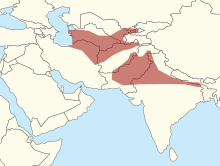Central Asian cobra
| Central Asian cobra | ||||||||||||
|---|---|---|---|---|---|---|---|---|---|---|---|---|

Central Asian Cobra ( Naja oxiana ) |
||||||||||||
| Systematics | ||||||||||||
|
||||||||||||
| Scientific name | ||||||||||||
| Well oxiana | ||||||||||||
| ( Eichwald , 1831) |
The Caspian Cobra ( Naja Oxiana ) is one of within the family Venomari to the kind of genuine cobras ( Naja ).
Initial description
The first scientific description of Naja oxiana was carried out in 1831 by Karl Eduard Eichwald . He assigned them under the name Naja naja oxiana as a subspecies of the spectacled snake ( Naja naja ).
features
Well oxiana reaches a total length of 100 to 150 cm with a slim, but nevertheless strong physique. The relatively short head is only slightly separated from the neck and has a rounded snout. The eyes have a round pupil . The following pholidotic features can be found on the head: 7 upper lip shields ( scutum supralabiale ), of which the third is the tallest and the seventh is the longest, a front eye shield ( scutum preoculare ) and two back eye shields ( scutum postoculare ). The 3rd and 4th shields of the upper lip touch the lower edge of the eye. The snout shield ( Scutum rostrale ) is slightly wider than it is high. The neck is covered by 25 rows and the back by 21 rows of smooth scales. On the underside there are around 108 ventral scutums ( scutum ventrale ) and 73 under- tail shields ( scutum subcaudale ). The anal shield ( scutum anale ) is not divided. The body color of adults is brown or gray, underneath yellowish white and not spotted. Young animals in particular have black cross bars on the back, the front eight of which go to the belly side.
Like all Venomari has Naja Oxiana to venom glands reformed salivary glands , which via a channel with poison in the front upper jaw located, non-movable fangs are connected (proteroglyphe tooth position).
Occurrence
The species occurs in the following countries: Afghanistan , northern India , northeastern Iran , Kyrgyzstan , western Pakistan , Tajikistan , Turkmenistan and Uzbekistan . The populated habitats (deserts, semi-deserts, mountain regions) have hot summers with air temperatures of up to 40 ° C and relatively mild winters with average temperatures of 10 to 20 ° C and rare frosts down to −15 ° C. The biotopes have rocks, scree slopes and low vegetation . Occasionally Naja oxiana invades gardens.
Way of life
The Central Asian cobra reproduces through oviparia (laying eggs). The clutch comprises 8 to 12 eggs, which measure approximately 33 to 38 mm in length. In Turkmenistan, eggs are laid between July and August and the young snakes hatch after about two months. The snake's range of prey includes small mammals such as mice , frogs (e.g. Bufo viridis ) and other reptiles ( lizards and other snakes, e.g. Natrix tessellata ), and more rarely birds . The Central Asian cobra mainly lives on the ground, but also climbs in bushes and trees to search for prey. Most of the time the animal is diurnal and lives on the ground. During the cold season the species hibernates for about six months. It is active both day and night, depending on the weather. When threatened, it straightens its front body and, by spreading its front ribs, puts on the hat that is characteristic of cobras. Well oxiana defends itself by poison bites , but not by poison spitting .
toxicology
The toxin mixture of the Central Asian cobra is extremely potent, the poison bite is life-threatening for humans. The poison primarily contains postsynaptic neurotoxins (e.g. short neurotoxin 1, a three-finger toxin ), which act as antagonists on peripheral nicotine receptors , as well as cytotoxins such as cytotoxin 2 (also a three-finger toxin), which is associated with interacts with the biomembrane of cells and leads to cytolysis .
According to Latifi et al. (1985) about 100 (± 25) mg of poisonous mixture (dry weight) are released. After a bite in humans, non-specific general symptoms (e.g. headache , nausea , vomiting , abdominal pain , diarrhea , dizziness , shock , cramps ) can occur. Pain , swelling, edema , blistering, and necrosis may occur locally . The neurotoxins cause progressive paralysis, which is initially noticeable as ptosis and can lead to complete paralysis . Death occurs through respiratory paralysis .
The following antivenins are available:
- Polyvalent Snake Antivenin (Razi Serum and Vaccine Research Institute, Iran)
- Polyvalent Snake Venom Antiserum (Vacsera, Egypt).
Species protection
Well oxiana is listed in Appendix B of the EU Species Protection Ordinance , so keeping it in captivity is notifiable.
literature
- Ludwig Trutnau: poisonous snakes . Eugen Ulmer, Stuttgart 1998.
Individual evidence
- ↑ UniProt: Short Neurotoxin 1 (accessed August 25, 2015)
- ↑ UniProt: Cytotoxin 2 (accessed on August 25, 2015)
- ↑ a b WCH Clinical Toxinology Resources: Naja oxiana (accessed August 25, 2015)
Web links
- Well oxiana in The Reptile Database
- IUCN Red List: Naja oxiana (accessed August 25, 2015)
